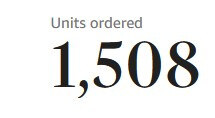Distribution vs. Sales

Lately I’ve seen a trend in the indie world where authors are posting snapshots of their KDP distribution celebrating hundreds or even thousands of ‘sales’. Besides popping up on my own social media timelines, a few of my authors have sent me the posts asking why their book isn’t doing as well and how they are failing as authors. I tell them all the same thing: sometimes numbers lie.
It’s well established that indie authors have to work ridiculously hard to carve out a space in the literary world. When it comes down to it, indie authors have to do all the gritty work that a trad author would have a whole team for. Thousands of hours are put into a book and usually the return does not equal or come close to the investment. It’s daunting. It’s exhausting. It’s eternal.
Because of that, we often look for things to validate our experience and energy. We compare ourselves to each other and to trad authors, and often we try to mimic what the trad authors and publishers are doing. I think this can lead to disappointment and is a disservice to our work and ourselves. What works for the trad doesn’t always pan out for the indie press and very rarely for the self-published. We just don’t have the resources that the big houses have. It is what it is.
But we have a lot of other things going for us that should be celebrated: our creativity, our independence and freedom, our weirdness, and our passion. Those are the things we should lean into.
So let’s talk about the conflation of sales numbers and distribution numbers.
They are not the same.
Almost every time I see the posts of hundreds or thousands of sales it is because the author has run a free ebook promotion that resulted in a whole lot of downloads. Scrolling a few posts back, I typically find the free ebook announcement. Even if there isn’t an announcement, a quick look at thier audience engagement and their rankings on amazon will tell me that it was likely a free promotion - not hundreds and thousands of sales.
There is absolutely nothing wrong with free ebook promotions. If you’re looking to bulk distribute and get lots of downloads fast, or host a giveaway, it’s a great resource. I myself have done free ebook promotions in the past because it gave my ebook a much higher chance of hitting #1 in multiple categories and I wanted the bragging rights and sweet orange ribbon.
But free downloads and sales are two completely different things and should not be grouped together. I saw a creator on tik tok posting thousands of sales in the first week of release but in the comments wrote that only fifty of them were print copies and the rest were free ebook downloads. It’s misleading to post that you’re selling thousands of books when you simply aren’t.
Now I’m not trying to talk smack on any person who has done this. You do you, boo. I would ask you, though, why you feel the need to exaggerate your numbers and lie to your audience? Why do you feel you have to prove that your work is good enough?
Maybe you haven’t reached hundreds or thousands of physical sales but the book industry is playing the long game and success doesn’t happen overnight.
Can you become a sensation overnight and sell thousands of copies? Of course you can. But that is the exception, not the rule.
A lot of hidden truths about the publishing industry came out during the Penguin Random House/Simon & Schuster antitrust trial. If you never looked into it, you absolutely should. Although the merge was ultimately blocked, the time in trial broke through the illusions of trad publishing with some raw and gritty details. Peep this stat I snagged from Jane Friedman:

Of all the publishing statistics shared at the DOJ-PRH antitrust trial, that top bullet point is the one that really opens people's eyes.
But what does it mean?
It is a little bit misleading, if still a good wake-up call for authors about the realities of book publishing, and how many books don't financially succeed.
The testimony didn't refer to the exact source being used here, but my best guess is they're counting ISBN numbers from Bowker for that 58,000 title count—looking at all traditional publishers who use ISBNs on their books. And as far as sales figures, I assume that's coming from NPD Bookscan, which tracks print retail sales in the United States. It's possible many books sold more than a dozen copies, just not in print and/or not through retail channels (e.g., Amazon, Barnes & Noble, your indie bookstore on the corner, etc). I wouldn't be surprised if scholarly/university presses play a role in keeping the average number low, since a lot of their sales are to libraries, and Bookscan does not track library sales. There are surely other factors as well.
Probably the more defensible figure shared at trial is the 90% one—that 90% sell fewer than 2,000 units. That's definitely from NPD Bookscan.
* sorry for the typo, that should be “trial” in the headline 🙃 - Jane Friedman
If you don’t catch my drift it’s simply this: the numbers don’t equal value and it shouldn’t equal success. You don’t need to compete. You just need to be.
I hope this opens up some conversation and retrospection on the topic of distribution numbers vs. sale numbers. My purpose is not to make anyone feel bad, but rather remind you that numbers are a game and your value as an author is not determined by them.
We hold the traditional publishing world accountable for their transparency. How do we as indie authors apply the same standard to ourselves?
-Ravven

Thanks for reading The Quaint and Curious! Subscribe for free to receive new posts and support my work.



